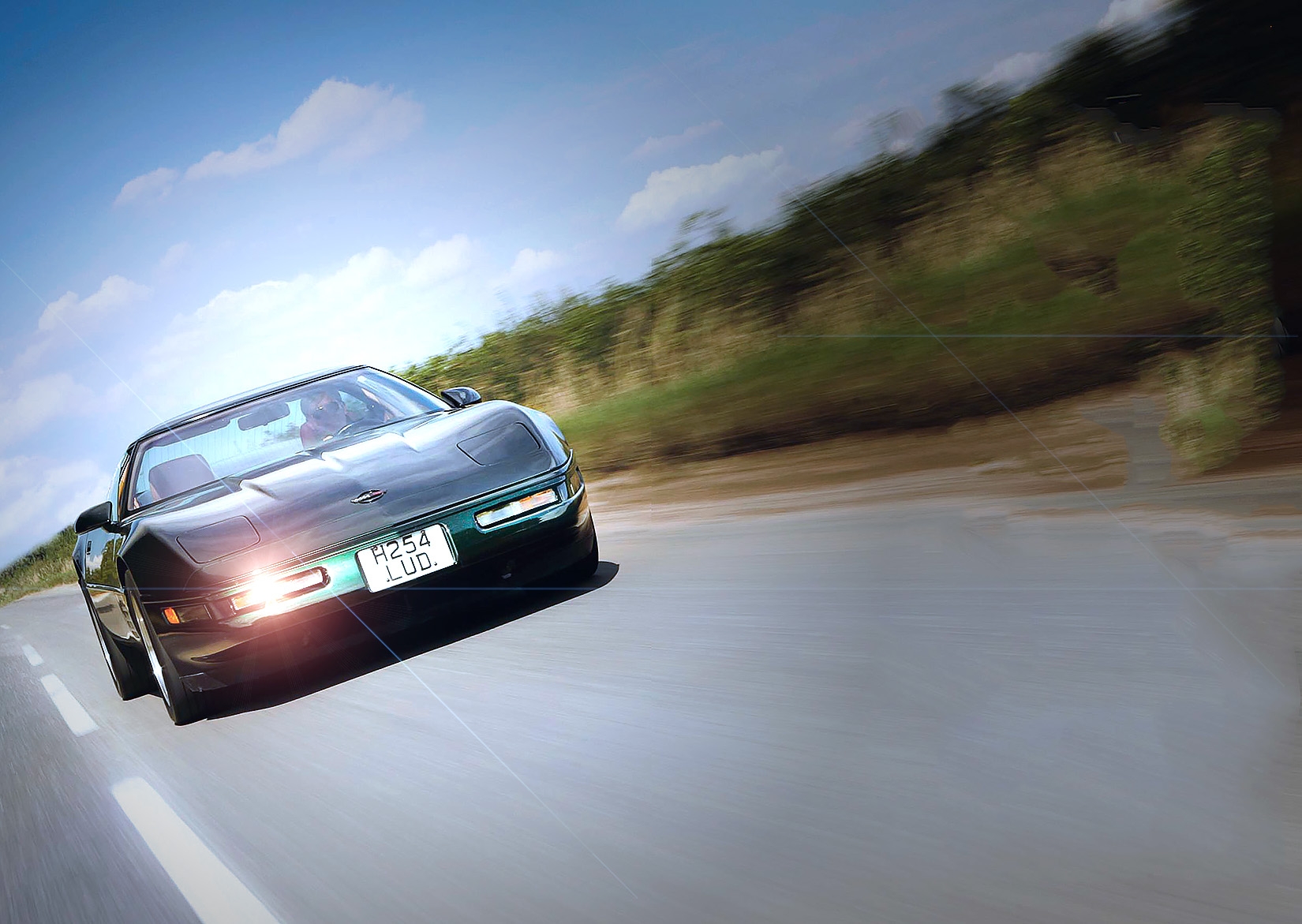
Over here – 1991 Chevrolet Corvette ZR-1 road test. Chevy’s plan for the Corvette ZR-1 was ambitious – to cross the Atlantic and take on Porsche and Ferrari in their own back yard with the help of Lotus. We find out how close it came. Words: Rob Scorah. Photography: Lyndon McNeil.
Hmmm. I think I ought to have both hands on the steering wheel. Forget any elbow-on-top-of-the-door American car affectations. We’ve got a live one here – the exotic edition of Chevrolet’s C4 Corvette, the ZR-1.
Ambling along at 50mph, I’m immediately made to feel like I’ve come out to drive. I’m held in Recaro style by a tight leather sports seat, legs flat out in front, the big wheel fairly close in my lap. Everything’s where I want it; the gearstick just a flick of the wrist away. Dials are clearly visible, as are temperature and pressure gauges – rare. I’m sure there’s all that other stuff – air-con, hi-fi – but there’s something else more compelling.
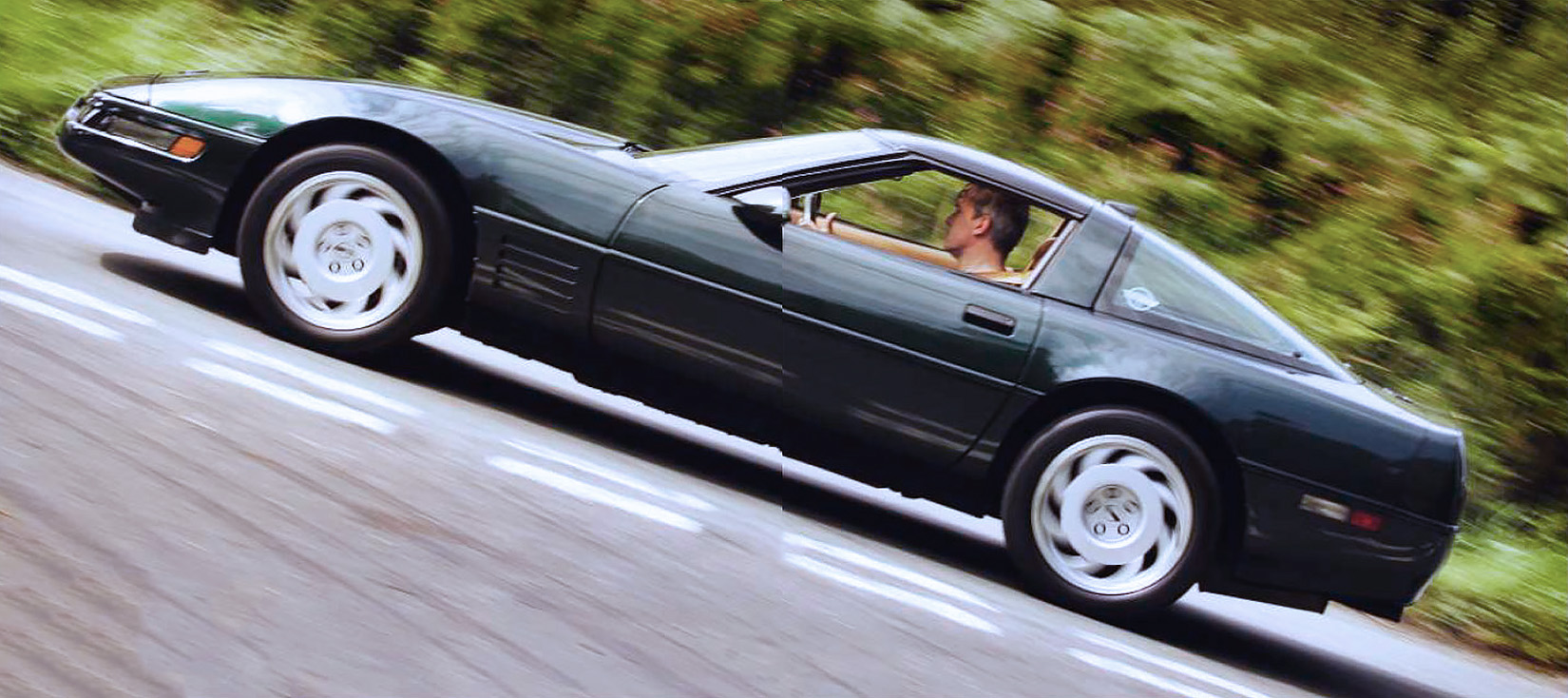
Firstly it’s the sound; an old-school V8 growl rounded off and an eerily animal warble, rising as I press the throttle. And it’s the way this Corvette seems to be answering its controls – more eager, more like a Porsche 928 or Ferrari Testarossa.
And like them, the ZR-1 can take an effortless swiftness and turn it into a sudden blaze of dynamic force; drop a gear, foot down.
The ZR-1 bolts forward with express-train relentlessness, the low muted growl of the engine quickly overlaid with a rising cry – part snarl, part wail. The vigour and noise of the LT5 engine is the big surprise of the ZR-1. Each time I spool up through the revs the motor’s song accompanies the turbine thrust as the road rushes underneath the car like a river in flood. From standing, two gearchanges will shunt me into three-figure speeds. Luckily, the controls feel very much in touch with the road. The steering and brakes are servo’d but they respond in kind to your effort, and the stance of the car can be altered in bends as much with a gentle curl of the toes as with the steering – the nose subtly tucking in if you throttle off gently.
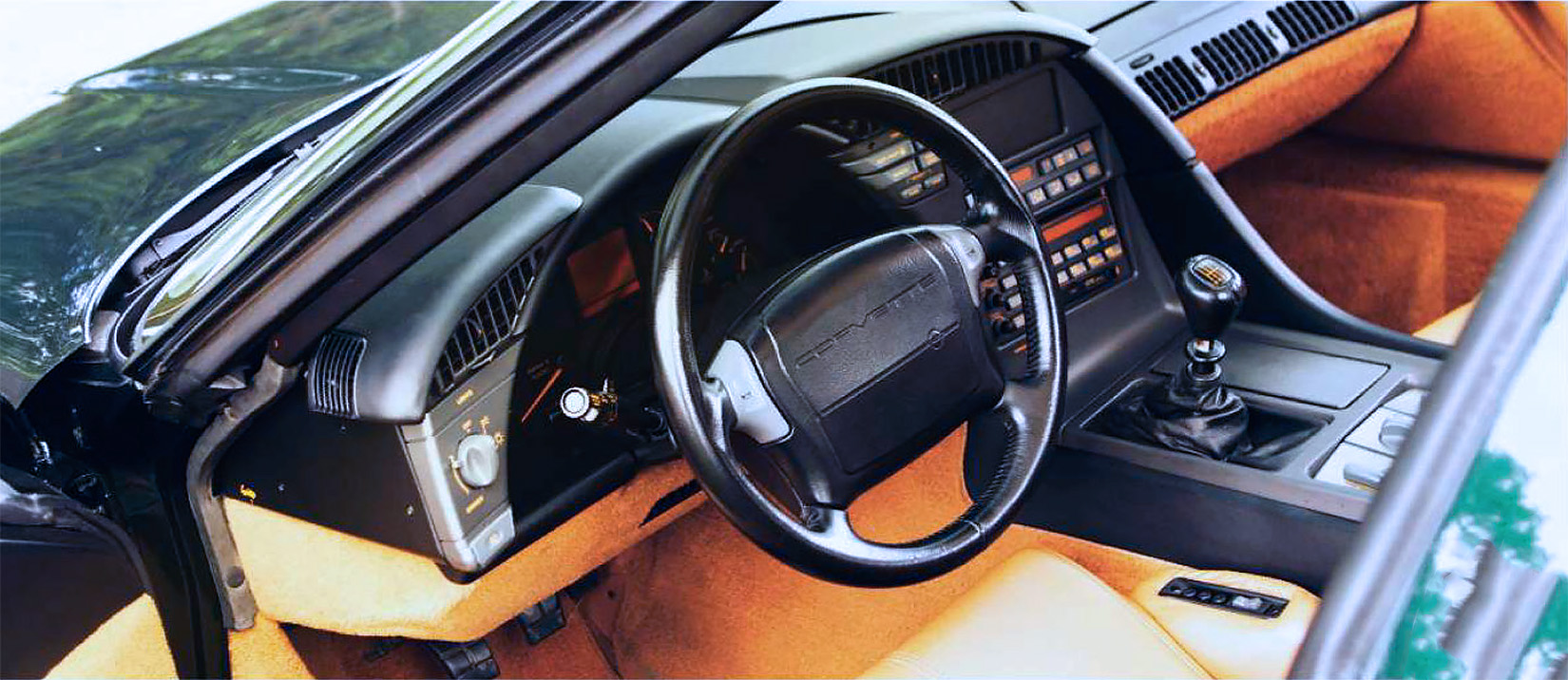
Digital dashboard was inspired by the F14 Tomcat plane made famous in Top Gun
As the weight shifts there’s that moment where I could easily throw it into a powerslide – I can feel exactly where the balance is in the chassis – but that would cancel out this Corvette’s poise, and waste the phenomenal grip from those huge tyres. Still, as the roads narrow, some might fear the return of those cliched American handling traits, but a ZR-1 will follow or lead anywhere the 928 or Testarossa will go.
It is an immense ground coverer. I could drive this thing all the way to Prague and back, and get out with no aches or stiffness
Like the Europeans, the ZR-1 is about sports touring; keep pushing, keep driving, keep feeling. It is an immense ground coverer; and though people keep telling me that Corvettes ride hard, I could drive this thing all the way to Prague and back, and get out without any aches or stiffness.
When the model first appeared in 1989 the widened rear, with its tiny red-and-black badge, signified a great deal to the Corvette faithful. It meant that Corvette chief engineer Dave McLellan had re-invoked one of the great names of power, a performance option code not seen since the mighty Stingray ZR1 of 1969-71. Hopefully he – and it – would restore the marque’s performance honour.
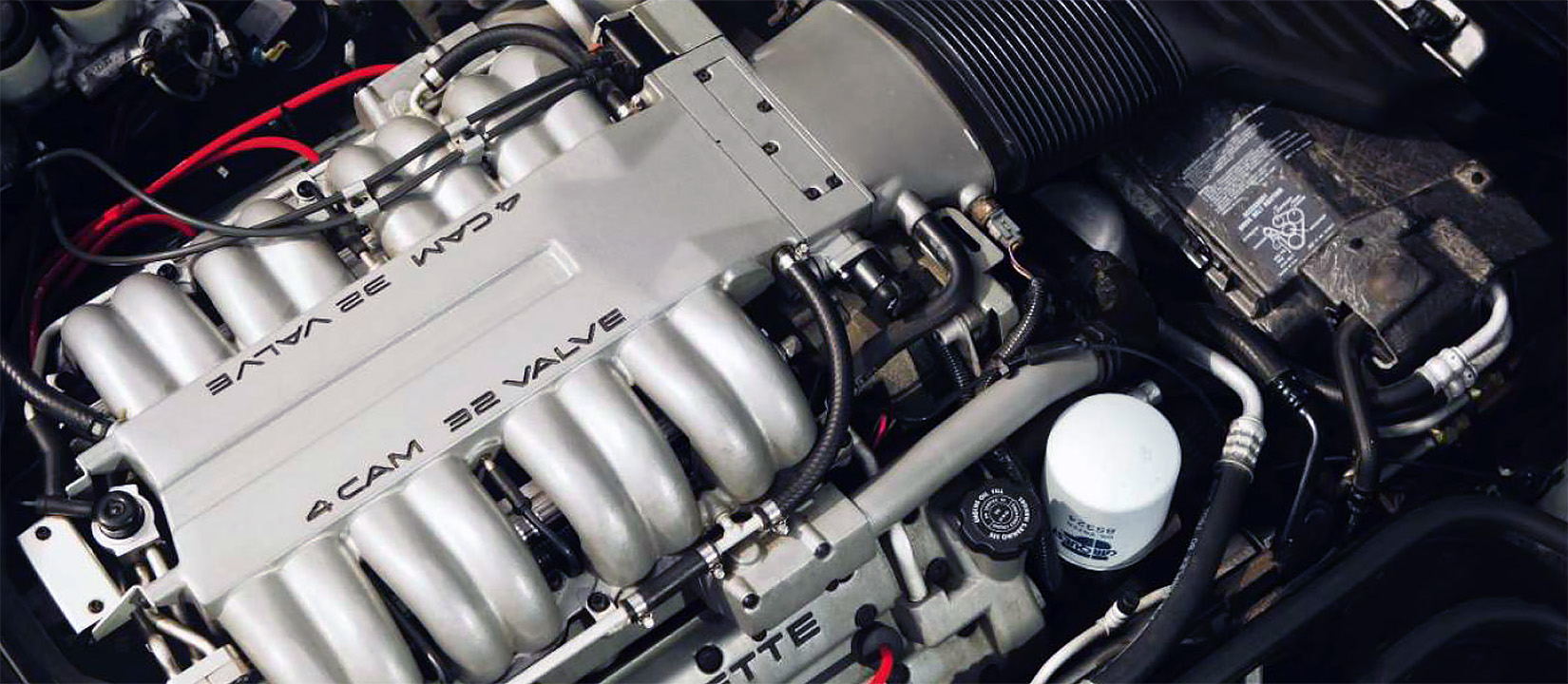
In the interim, anyone could have been forgiven for losing faith in the American icon. Things had gotten pretty out of shape for the Plastic Fantastic in the late Seventies as uninspired stylists exaggerated the ‘Coke Bottle’ Stingray theme, and performance engineers battled unsuccessfully with emissions regulations. Despite multi-vaned wheels, balloon tyres, decals, slats and names like ‘Rally Sport’, no one, certainly not outside the US, could discern anything terribly sporting going on.
‘Porsche’s 928 was a benchmark,’ says McLellan, ‘though as a sports car it was too slick and too smooth. Its balance and powertrain layout influenced the C4, and the Chevrolet guys took a good look at its engine too. Porsche’s all-alloy 4.5-litre V8 made 250bhp; 300bhp in ‘S’ form by the time the C4 came out. Projected to Corvette capacity, it was a more powerful unit, and where Chevrolet’s 5.7-litre ‘small block’ V8 (L98) was a pushrod engine, the 928 used a single overhead camshaft on each cylinder bank. Cams in the heads would potentially lighten and stiffen the valvetrain, and eliminate the need to reroute the flow of the intake ports around the pushrods.
The Chevrolet Corvette C4 was far more sophisticated than many, including its home buyers, would give it credit for. It had innovative all-new, aluminium-forged, five-link rear suspension, a Grumman Aircraft Company computer-aided-design crash cell and digital instruments. But Roy Midglev and the engine guys were having trouble getting its own V8 much past 250bhp in road-going, emissions-compliant form. McLellan and Chevrolet vice-president Lloyd Reuss were eager for new solutions that would make the Corvette king in the horsepower stakes.
Turbocharging seemed the simplest solution but, from an image perspective, strapping on a turbo was seen as pretty low-tech. To McLellan and Reuss, the draw and potential of the European multi-valve overhead-cam engines was irresistible, both as a marketing tool and the ‘sophisticated’ path to power. But no one in General Motors built such a motor.
‘It was one of those serendipity moments,’ says McLellan. ‘Lloyd told Russ Gee (head of powertrain) to get on a plane and find someone who can do it.’ Reuss said that GM would ‘bite the bullet’ on the project’s costs. One of those planes led to the UK and Lotus.
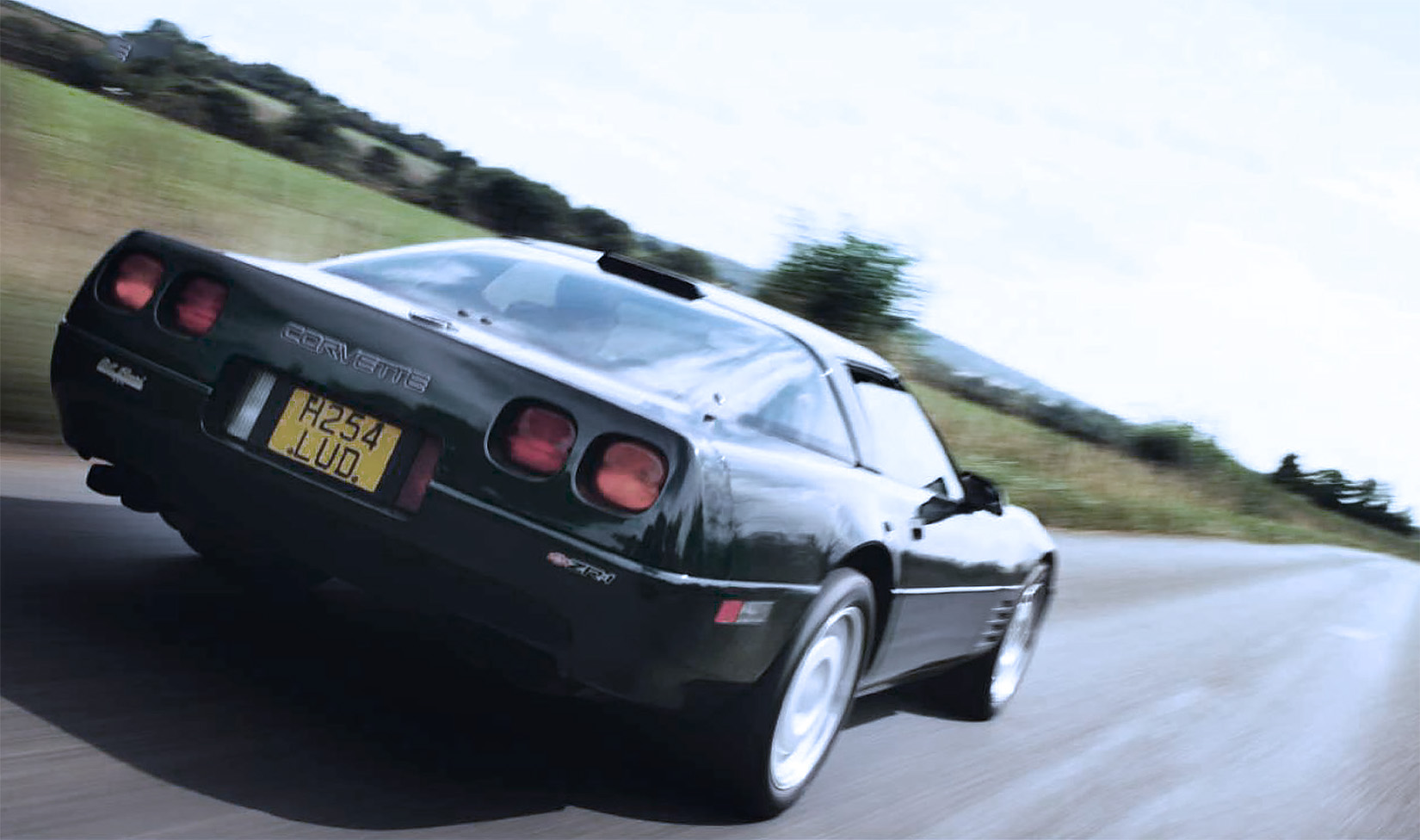
Designer Jerry Palmer re-used themes from his 1977 Aerovette concept on the Corvette C4
At the end of the Seventies Colin Chapman gave the go-ahead to engineer Tony Rudd to begin work on a V8. The all-alloy quad-cam Lotus DV8 (Type 909) engine was projected to yield 320bhp and 300lb ft of torque, and would match the company’s supercar pretentions by going into the proposed Esprit-derived Etna. It was hoped it’d share as many components as possible with the Lotus 16-valve slant-four. It would also meet US emissions regulations.
By 1984, while McLellan’s chiselled new Corvette was making the show rounds, still equipped with the old-school Chevrolet small block, the mid-engined Etna concept made the stand at the Birmingham NEC Motor Show. The Lotus V8 was its most developed aspect. But by this time Chapman was dead and Lotus was in danger of losing its way. Luckily, though the Etna was axed, when Gee came calling, Rudd and his development team were still in place. ‘We got along wonderfully with them,’ says McLellan. ‘Tony Rudd was a very bright and capable engineer.’
Rudd reckoned that new heads on the small block would yield 350bhp, though the Corvette target was 400bhp and 400lb ft of torque. He also convinced Midgley that they would get more power by managing the cooling better, and that they needed an alloy block – in other words, an all-new engine. Even so, Midgley would insist on using the same 4.4in bore centres as the small block, so that it too might conceivably use the multi-valve heads. But for the ZR-1 project, could they not use the Lotus Type 909 motor?
Project key players Dave McLellan and Gary Cline both still have ZR-1s and the Lotus-Mercury-Chevrolet development team still meet for Christmas dinner
‘Packaging the engine was the biggest challenge,’ says Ian Doble, the first project manager at the Lotus end of what was becoming the LT5 engine programme. ‘It had to fit in the Corvette engine bay and it had to go up between the chassis rails to be fitted.’ That meant it could be no more than 695mm across the cam covers and manifolds. The Lotus V8 had been built without any such constraints and was much larger. As well as smaller, the LT5 needed to be of greater capacity – by 50 per cent-and produce 100bhp more. Using the Type 909 as a template Rudd got to work on the basic layout of the LT5, while Doble’s colleague, engineer Dave Whitehead, filled in the detail. The 90-degree, alloy block motor would use silicon carbide-impregnated nickel – Nikasil – wet liners with cast aluminium flat-topped pistons and forged steel conrods.
Meanwhile, Midgley was trying to find someone who could build the motor. Chevrolet, knocking out 2500 V8s a day, had no place to build 25 boutique engines on the same assembly lines, nor was it economic for Lotus to retool. But there was an ideal candidate; Mercury Marine (MerCruiser) of Stillwater, Oklahoma. ‘Mercury had experience in low-volume production and machining aluminium,’ says Gary Cline, MerCruiser’s project engineer. ‘We had built our own four-cylinder engine, but this was our first V8.’
As the assignment took shape, men and information flew back and forth between Hethel and Stillwater. ‘It was a real feat of project management,’ remembers Doble. ‘I used to have to fly over every Thursday to Michigan and back on Sunday. This was before email and the internet. The Lotus boys would work on a problem then send us their results. With the time delay, there would be a pile of faxes waiting for us on the floor when we came in to work.
CHRIS BOYD, CORVETTE ZR-1 OWNER
‘I don’t think I’m your typical ZR-1 owner,’ says commercial pilot Chris Boyd. ‘It was my dad who was always into Corvettes, he had a couple of Stingrays, but I always thought they were a bit brassy. I wanted a Porsche 911 Turbo when I was a kid.
‘The draw of the European multi-valve overhead-cam engines was irresistible, both as a marketing tool and the “sophisticated” path to power’
‘But I’d go to Corvette meets with my dad in the late Nineties and I saw ZR-1s. I liked the wider bodies and bigger tyres compared to the standard C4. When I was working I started looking at 911 Turbo prices, but I couldn’t get close – I could afford a ZR-1. They give incredible performance for the money; I got my black-on-black 1992 for £17,500 two years ago from a club guy. It’s starting to suffer from that windscreen delaminating issue (around the edges) that they all get, but apart from that it’s unburstable. I probably don’t spend more than £500 a year on it – excluding tyres – but I only do around 3000 miles in it.’
‘The gearchange will have you hustling A-roads rapidly. Five- four for a relaxed overtake. Four to two? Slingshot’
There was a big learning curve – they learned about manufacturing from us and we learned about engineering from them.’
MerCruiser was tooling up in earnest for the new job, even creating new machinery; project manager Terry Stinson designed a $750,000 camshaft boring machine. The LT5 cylinder head and cam cover had to be finished as a single unit, making it impossible to support boring tools inside them. His new rig could drill the near- three-foot-long, inch-wide tunnels to within 0.001 in tolerances.
Down on the shop floor, the engine builders were as diligent as the developers. There were ten or 12 assembly stations,’ says Cline. ‘Most of the workers were women. They took so much pride in their work – if they didn’t like a part, it got rejected.’
Like an Aston or Ferrari, that level of dedication shows in the engine. When you open the big clamshell Corvette bonnet and gaze down into that bay, just looking at that motor, you know that this is what the ZR-1 is all about. It looks like anything but someone’s first attempt at a V8. The tight space makes the motor look more solid and massive – that smooth, sculptured intake plenum clenched powerfully around its top. And those words etched in angular script into the metal: 4 Cam 32 Valve. ‘It had some mystique about it,’ smiles Cline. That arrangement was unique for that time in the US.’ Even if you didn’t know what it meant, start-up will tell you this isn’t the same old American song – it doesn’t choke into that rumbling, asymmetric gurgle. The throb is there, but so is the whisper of chains and the sibilant tapping of the multiple camshafts.
One thing the orange tacho needle tells you is how quickly the motor responds to your foot, revving immediately with that strange swishing moan. Slotting into first gear, the tone diminishes to the low rumble. On a slow, low-revs getaway, the box locks out second and diverts you away to fourth, conserving fuel and allowing the animal to mooch nonchalantly along. Whatever the engine may promise, the ZR-1 has been bred to behave in all situations, with no snatch in the drivetrain and great fluidity of throttle response.
The ZR-1 had to jump through the most inane hoops to gain CM approval as to how it might be accepted by the American buyers. As well as the more direct comparisons with cars like the Testarossa and Porsche 928 on long-distance treks, the new Corvette would have to remain placid in top at 55mph while ascending a 10 per cent gradient for ten miles. Or maybe drive for mile after mile at 5000rpm – in second. The average American buyer didn’t have a lot of mechanical sympathy,’ says Doble tactfully. A Ferrari engineer would have had an apoplectic fit if his creation was treated so. Still, it all gives the enthusiast buyer a hugely competent machine.
Coming into traffic, the ZR-1 simply slows, splutter-free to pad behind the buses, but there’s always the hint of V8 low-down grunt. Rolling my right foot slowly on my heel brings an immediate but gentle reaction, the kind that only big power, finely tuned can bring. That motor could just spool up from any speed in any gear and kick you forward, but the ZF six-speed has tricks of its own. The straight-opposite three-four gearchange will have you hustling A-roads rapidly. Try six-five for a smart step up in your cruising speed, five-four for a relaxed overtake. Four to two? Slingshot.
Is the rear suspension – still with a transverse leaf spring – capable of putting all that power down? McLellan makes no apologies. ‘Work done in the aerospace industry allowed us to design a spring with the same tensile and strength properties in an epoxy laminate,’ he says. The composite springs were lighter and up to five times more durable.’
The ZR-1 was as good as they could make it and better than much of the more celebrated opposition. The LT5’s legacy would be two-fold. Its technology and its construction methods would be assimilated into a new series of Chevrolet aluminium-block V8s – but perhaps most importantly, the ZR-1 was the car that gave Corvette its mojo back. Drive one and you will know why.
| Car | 1991 Chevrolet Corvette ZR-1 C4 | ||
| Made in | USA | ||
| Cost new (1991 GB) | £31,500 | ||
|
Value now (2014 GB) |
£21,000 | ||
| Dimensions | |||
| Wheelbase | 2444mm | ||
| Overall width | 108mm | ||
| Front track | 1513mm | ||
| Ground clearance (unladen) | 127mm | ||
| Front headroom (seat uncompressed) | – | ||
| Rear headroom (seat uncompressed) | – | ||
| Front legroom (seat forward/back) | – | ||
| Overall length | 4483mm | ||
| Overall height (unladen) | 1186mm | ||
| Rear track | 1534mm | ||
| Front shoulder room | – | ||
| Rear shoulder room | – | ||
| Rear legroom (seat forward/back) | – | ||
| Mechanical Specification | |||
| Weight (in lbs kerb) |
1573kg (3465lb) | ||
| Steering |
Rack and pinion, hydraulic power assistance. Steering wheel diameter 14.4in., 21/2 turns lock to lock. |
||
| Turning circle |
33ft | ||
| Turns (lock to lock) |
2.5 | ||
| Brakes |
Dual circuits, split front/rear. Front 5in. (292mm) dia ventilated discs. Rear 11.5in. (292mm) dia ventilated discs. Vacuum servo. Handbrake, centre lever acting on rear discs. |
||
| Engine |
|||
| Main | Longways front, rear-wheel drive. 8 cylinders in 90 deg V8, bored block, electric fan. | ||
| Material | Mead/block cast iron/cast iron | ||
| Main bearings (number) |
5 | ||
| Cooling system |
water | ||
| Valve gear layout |
dohc per bank | ||
| Carburettors/injections |
Rochester electronic port fuel injection / Eectronic ignition | ||
| Compression ratio |
9.0:1 | ||
| Capacity (cc) |
5727 | ||
| Bore (mm) |
101.6 | ||
| Stroke (mm) |
87.1 | ||
| Power (net bhp/rpm) DIN |
380bhp at 6000rpm | ||
| Torque (net lb ft/rpm) DIN |
375lb/ft at 4000rpm | ||
| Transmission | |||
| Gearbox |
ZF six-speed manual, limited-slip differential, rear-wheel drive |
||
| Top gear mph per 1000rpm | 34.81 mph | ||
| Ratios: | – | ||
| Final drive ratio |
4.375:1 | ||
| Clutch : Make: |
ZF | ||
| Type |
– | ||
| spring single plate | – | ||
| Wheels and Tyres | |||
| Wheels (type and size) |
Aluminium alloy, 8.5in. rims |
||
| Tyres (type and size) | Goodyear Eagle tyres, size 225/50VR-16in. pressure F35 R35 psi (normal driving). | ||
| Replenishment & Lubrication | |||
| Type of oil | 15W/40 | ||
| Engine sump capacity (pints) | 15.2 | ||
| Engine oil change interval (miles) | 20 000 | ||
| Gearbox and final drive capacity (pints) | 3.9 | ||
| Type |
SAE 80 | ||
| Gearbox capacity (pints) | – | ||
| Final drive capacity (pints) |
– | ||
| Type | – | ||
| Lighting | |||
| Number of lights | six | ||
| Type |
Tungsten halogen | ||
| Battery (make) | Bosch | ||
| Voltage |
Battery 12v, 54Ah. Alternator 97A. Headlamps 120/110W. Reversing lamp standard, electric fuses. 2-speed, plus intermittent screen wipers. Electric screen washer. Air-blending interior heater; air conditioning standard. PVC seats, plastic foam headlining. Carpet with heel mat floor cover. Scissor jack; 2 jacking points each side. Laminated windscreen. |
||
| Suspension | |||
| Front |
independent, glass fibre transverse leaf spring, wishbones, telescopic dampers, anti-roll bar. |
||
| Rear | independent, glass fibre transverse leaf spring, fixed length drive shafts, wishbone geometry links, telescopic dampers, anti-roll bar. | ||
| Price structure (1971) | |||
| Basic price, £ | 28 757 | ||
| Purchase tax | – | ||
| Extras (including tax) | |||
| Leather trim | – | ||
| Tinted glass | – | ||
| Airconditioning | basic | ||
| Radio | basic | ||
| Fog lamps—2 | – | ||
| Automatic transmission | – | ||
| Power steering | basic equipment | ||
| Airconditioning (including tinted glass) | – | ||
| Indicates fitted to test car |
|||
| Price as tested | – | ||
| Braking (Actual stopping distance in feet) | |||
| 30mph | 49 | ||
| 70mph | 166 | ||
| Fuel consumption | |||
| Overall (mpg) |
16.4(16.9 litres/100km) | ||
| Driven carefully (mpg) | 20.1 | ||
| Star rating | 3 | ||
| Range |
400/440 miles | ||
| Tank capacity |
16.7 gallons (76 litres) | ||
| Performance | |||
| Standing 1/4-mile: | – | – | |
| Standing 1 km | – | – | |
| From standstill to mph. in seconds | |||
| True mph | Time (sec) | Speedo mph | |
| 0-30 | – | 30 | |
| 0-40 | – | 40 | |
| 0-50 | – | 50 | |
| 0-60 | 5.6 | 60 | |
| 0-70 | 70 | ||
| 0-80 | 80 | ||
| 0-90 | 90 | ||
| 0-100 | 99 | ||
| 0-110 | 109 | ||
| 0-120 | 120 | ||
| 0-130 | 131 | ||
| 0-140 | 142 | ||
|
Speeds in gears. From minimum to maximum in each gear. |
|||
|
Gear |
Mph | Kph | rpm |
|
1 |
41 | 66 | |
| 2 | 78 | 126 | |
| 3 | |||
| 4 | |||
| 5 | 127 | 204 | |
| 6 | |||
| 180mph | |||





